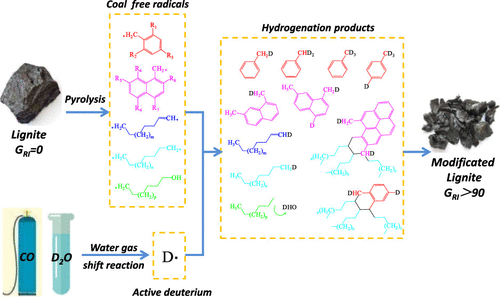当前位置:
X-MOL 学术
›
Energy Fuels
›
论文详情
Our official English website, www.x-mol.net, welcomes your feedback! (Note: you will need to create a separate account there.)
Isotope Labeling to Study the Hydrogen Transfer Route during Lignite Modification in a Subcritical D2O–CO System
Energy & Fuels ( IF 5.3 ) Pub Date : 2020-03-29 , DOI: 10.1021/acs.energyfuels.9b04472 Qi Wang 1 , Yuqiong Zhao 1 , Yongfa Zhang 1 , Tiankai Zhang 1 , Shouqi He 1 , Yongyong Wei 1
Energy & Fuels ( IF 5.3 ) Pub Date : 2020-03-29 , DOI: 10.1021/acs.energyfuels.9b04472 Qi Wang 1 , Yuqiong Zhao 1 , Yongfa Zhang 1 , Tiankai Zhang 1 , Shouqi He 1 , Yongyong Wei 1
Affiliation

|
The hydrogen transfer reaction is one of the key chemical processes of coal conversion. The elucidation of the hydrogen transfer mechanism is essential for rational control of the properties and distribution of products. This paper is focused on the hydrogen transfer mechanism of lignite modification in a subcritical D2O–CO system. Using Soxhlet extraction, isotope ratio mass spectrometry, 1H nuclear magnetic resonance, and pyrolysis–gas chromatography–mass spectrometry (Py-GCMS), the deuterium transfer routes in deuterated products and their representative structures were studied. The existing form of deuterium in deuterated products was also proposed. The results showed that the subcritical D2O–CO system can generate active deuterium, which combines with the free radical fragments resulting from coal pyrolysis to form three kinds of deuterated products: n-hexane solute (NS-D), benzene solute (BS-D), and tetrahydrofuran solute (TS-D). Deuterium in the three solutes migrates in the order TS-D → BS-D → NS-D. It was observed that the active deuterium is not transferred to the β sites of the solutes but rather to their ar, α,2, α, and γ sites. Py-GCMS detection results showed that the solutes mainly consist of six representative structures, that is, monocyclic and polycyclic aromatics, alkenes, alkanes, alcohols, and esters. In the modification process, deuterium is incorporated into the monocyclic aromatic structures in the aliphatic side chains first and then in the aromatic ring. For the polycyclic aromatic structures, the active deuterium enters the side chain first and then the aromatic ring having that side chain. A small amount of active deuterium can be incorporated into the alkene and alkane structures directly. However, it mainly transfers to such structures indirectly through thermal cracking of deuterium-containing macromolecular aromatic structures. Active deuterium reduces oxygen in the oxygen-containing structures to form OD or DHO, yet it cannot easily enter the aliphatic and aromatic structures linked to the oxygen-containing structures. This research provides a new perspective for the study of hydrogen transfer routes and can serve as a reference for discussing the molecular mechanisms involved in various coal conversion processes.
中文翻译:

同位素标记研究亚临界D 2 O–CO系统中褐煤改性过程中的氢转移路径
氢转移反应是煤转化的关键化学过程之一。阐明氢转移机制对于合理控制产品的性能和分布至关重要。本文重点研究了亚临界D 2 O-CO系统中褐煤改性的氢转移机理。使用索氏提取,同位素比质谱,1 H核磁共振和热解-气相色谱-质谱(Py-GCMS),研究了氘代产物中氘的转移途径及其代表性结构。还提出了氘代产品中氘的现有形式。结果表明,亚临界D 2O-CO系统可以生成活性氘,与来自煤热解产生的自由基片段结合形成3种氘化的产品,其中:Ñ-己烷溶质(NS-D),苯溶质(BS-D)和四氢呋喃溶质(TS-D)。三种溶质中的氘以TS-D→BS-D→NS-D的顺序迁移。观察到活性氘没有转移到溶质的β位,而是转移到其ar,α,2,α和γ位。Py-GCMS检测结果表明,溶质主要由六种代表性结构组成,即单环和多环芳烃,烯烃,烷烃,醇和酯。在改性过程中,氘首先被引入脂族侧链的单环芳族结构中,然后被引入芳族环中。对于多环芳族结构,活性氘首先进入侧链,然后进入具有该侧链的芳环。可以将少量活性氘直接掺入烯烃和烷烃结构中。然而,它主要通过含氘大分子芳族结构的热裂解间接转移到这种结构。活性氘还原含氧结构中的氧以形成OD或DHO,但它不能轻易进入与含氧结构相连的脂族和芳族结构。该研究为氢转移途径的研究提供了新的思路,可为探讨各种煤转化过程中涉及的分子机理提供参考。活性氘还原含氧结构中的氧以形成OD或DHO,但它不能轻易进入与含氧结构相连的脂族和芳族结构。该研究为氢转移途径的研究提供了新的思路,可为探讨各种煤转化过程中涉及的分子机理提供参考。活性氘还原含氧结构中的氧以形成OD或DHO,但它不能轻易进入与含氧结构相连的脂族和芳族结构。该研究为氢转移途径的研究提供了新的思路,可为探讨各种煤转化过程中涉及的分子机理提供参考。
更新日期:2020-03-29
中文翻译:

同位素标记研究亚临界D 2 O–CO系统中褐煤改性过程中的氢转移路径
氢转移反应是煤转化的关键化学过程之一。阐明氢转移机制对于合理控制产品的性能和分布至关重要。本文重点研究了亚临界D 2 O-CO系统中褐煤改性的氢转移机理。使用索氏提取,同位素比质谱,1 H核磁共振和热解-气相色谱-质谱(Py-GCMS),研究了氘代产物中氘的转移途径及其代表性结构。还提出了氘代产品中氘的现有形式。结果表明,亚临界D 2O-CO系统可以生成活性氘,与来自煤热解产生的自由基片段结合形成3种氘化的产品,其中:Ñ-己烷溶质(NS-D),苯溶质(BS-D)和四氢呋喃溶质(TS-D)。三种溶质中的氘以TS-D→BS-D→NS-D的顺序迁移。观察到活性氘没有转移到溶质的β位,而是转移到其ar,α,2,α和γ位。Py-GCMS检测结果表明,溶质主要由六种代表性结构组成,即单环和多环芳烃,烯烃,烷烃,醇和酯。在改性过程中,氘首先被引入脂族侧链的单环芳族结构中,然后被引入芳族环中。对于多环芳族结构,活性氘首先进入侧链,然后进入具有该侧链的芳环。可以将少量活性氘直接掺入烯烃和烷烃结构中。然而,它主要通过含氘大分子芳族结构的热裂解间接转移到这种结构。活性氘还原含氧结构中的氧以形成OD或DHO,但它不能轻易进入与含氧结构相连的脂族和芳族结构。该研究为氢转移途径的研究提供了新的思路,可为探讨各种煤转化过程中涉及的分子机理提供参考。活性氘还原含氧结构中的氧以形成OD或DHO,但它不能轻易进入与含氧结构相连的脂族和芳族结构。该研究为氢转移途径的研究提供了新的思路,可为探讨各种煤转化过程中涉及的分子机理提供参考。活性氘还原含氧结构中的氧以形成OD或DHO,但它不能轻易进入与含氧结构相连的脂族和芳族结构。该研究为氢转移途径的研究提供了新的思路,可为探讨各种煤转化过程中涉及的分子机理提供参考。



























 京公网安备 11010802027423号
京公网安备 11010802027423号